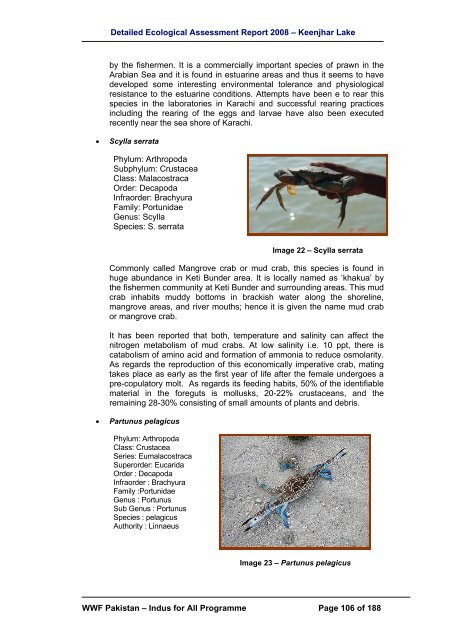Disclaimer note - WWF - Pakistan
Disclaimer note - WWF - Pakistan
Disclaimer note - WWF - Pakistan
Create successful ePaper yourself
Turn your PDF publications into a flip-book with our unique Google optimized e-Paper software.
Detailed Ecological Assessment Report 2008 – Keenjhar Lake<br />
by the fishermen. It is a commercially important species of prawn in the<br />
Arabian Sea and it is found in estuarine areas and thus it seems to have<br />
developed some interesting environmental tolerance and physiological<br />
resistance to the estuarine conditions. Attempts have been e to rear this<br />
species in the laboratories in Karachi and successful rearing practices<br />
including the rearing of the eggs and larvae have also been executed<br />
recently near the sea shore of Karachi.<br />
• Scylla serrata<br />
Phylum: Arthropoda<br />
Subphylum: Crustacea<br />
Class: Malacostraca<br />
Order: Decapoda<br />
Infraorder: Brachyura<br />
Family: Portunidae<br />
Genus: Scylla<br />
Species: S. serrata<br />
Commonly called Mangrove crab or mud crab, this species is found in<br />
huge abundance in Keti Bunder area. It is locally named as ‘khakua’ by<br />
the fishermen community at Keti Bunder and surrounding areas. This mud<br />
crab inhabits muddy bottoms in brackish water along the shoreline,<br />
mangrove areas, and river mouths; hence it is given the name mud crab<br />
or mangrove crab.<br />
It has been reported that both, temperature and salinity can affect the<br />
nitrogen metabolism of mud crabs. At low salinity i.e. 10 ppt, there is<br />
catabolism of amino acid and formation of ammonia to reduce osmolarity.<br />
As regards the reproduction of this economically imperative crab, mating<br />
takes place as early as the first year of life after the female undergoes a<br />
pre-copulatory molt. As regards its feeding habits, 50% of the identifiable<br />
material in the foreguts is mollusks, 20-22% crustaceans, and the<br />
remaining 28-30% consisting of small amounts of plants and debris.<br />
• Partunus pelagicus<br />
Phylum: Arthropoda<br />
Class: Crustacea<br />
Series: Eumalacostraca<br />
Superorder: Eucarida<br />
Order : Decapoda<br />
Infraorder : Brachyura<br />
Family :Portunidae<br />
Genus : Portunus<br />
Sub Genus : Portunus<br />
Species : pelagicus<br />
Authority : Linnaeus<br />
Image 22 – Scylla serrata<br />
Image 23 – Partunus pelagicus<br />
<strong>WWF</strong> <strong>Pakistan</strong> – Indus for All Programme Page 106 of 188

















